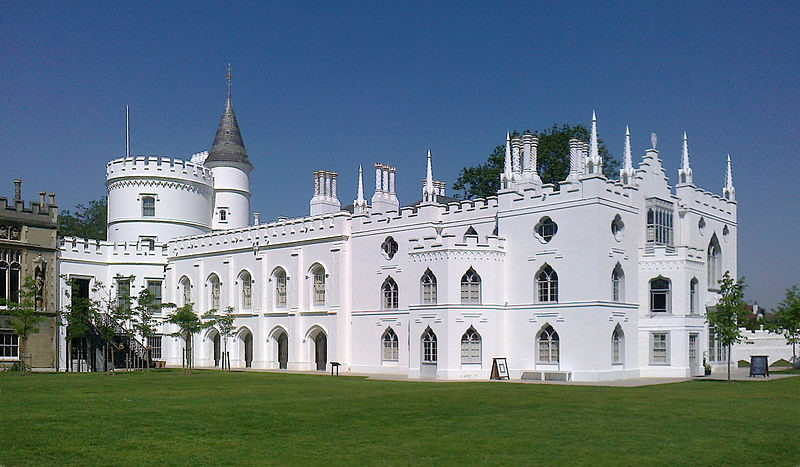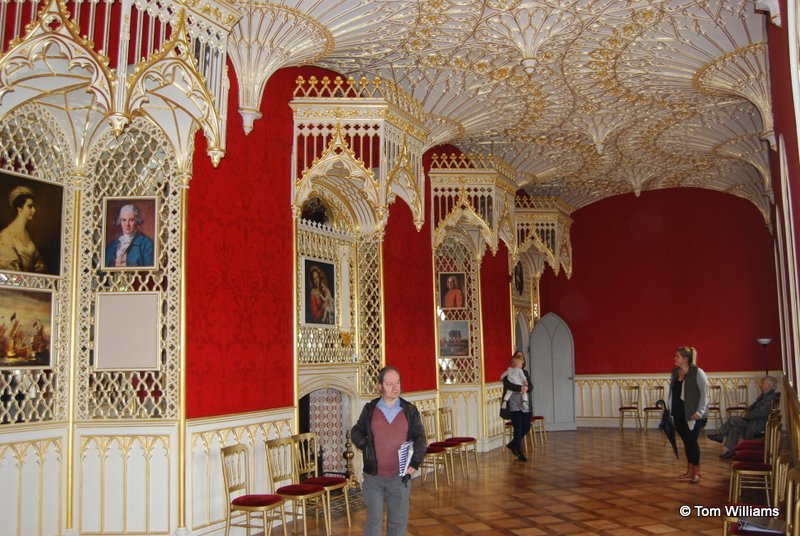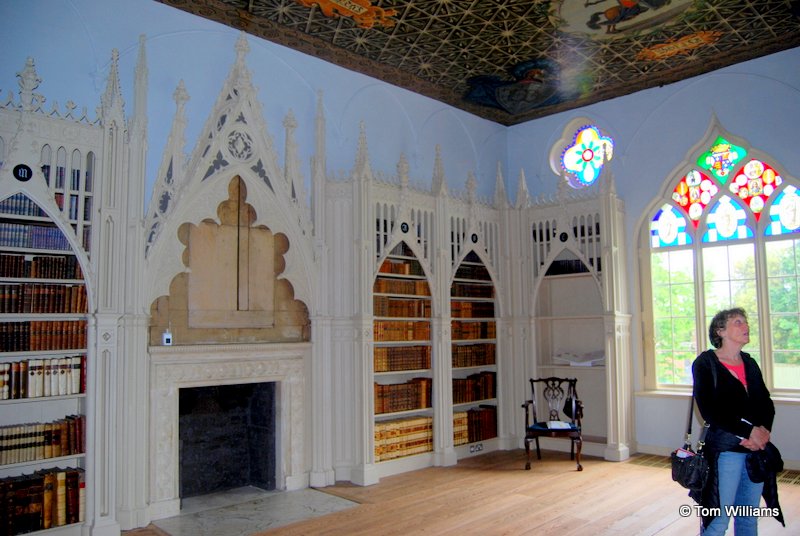In 1747, Horace Walpole, the son of Britain’s first Prime Minister, bought a small house near the Thames in Twickenham which he was to transform into a Gothic castle.
Where the Gothic Castle now stands was originally a small tenement, built in 1698 and let as a lodging house: Cibber once took it, and wrote one of his plays here.
From Walpole’s own ‘Description of the Villa of Horace Walpole’ (1774)
The original house (much embellished with what we might now think of as an excess of post-modern enthusiasm) can be made out on the right of the photo below, with the smaller windows.
Walpole was attracted to the location because of the many grand houses along the river nearby. Neighbours included Henrietta Howard at Marble Hill House, which I’ve written about here before. Alexander Pope, who had died in 1744 had lived less than half a mile away and built his famous grotto in Twickenham.
Walpole was an enthusiast for the revival of interest in Gothicism. His book, The Castle of Otranto, published in 1764, is regarded as Britain’s first Gothic novel. He decided to take the undistinguished house and convert it into a Gothic palace. The result was Strawberry Hill House.

Strawberry Hill House. Photo reproduced under Wiki Commons licence
Walpole’s grand design stretched as far as the round tower. The small section that stretches beyond the tower (with an outdoor staircase leading to the first floor) was built later as a ballroom and other rooms were added to the original house. The whole thing, as built by Walpole, combined a Gothic grandeur with a very domestic scale. If you count the windows, you’ll see that it’s not that large. Indeed, it was intended only as a summer villa and was closed up in the winter. Visiting it last weekend on a cold February Saturday, I can confirm that no one would want to stay there in the winter.
In 1923, the building was bought by the Catholic Church, who used it as a teacher training college. Walpole’s original building was used for teaching and as a residence for the monks and, indeed, the grounds and many of the later additions to Walpole’s house are still part of what is now St Mary’s University.
In 2007, the original parts of the House were leased to a Trust to restore it and open it to the public. They have done a splendid job and visitors can now enjoy the wonderful Gothic fake in all its 18th century glory. You enter through a dark, mysterious entrance hall through rooms lit by skylights and stained-glass windows, until you arrived in the great State Rooms, full of light and gilding, the journey from darkness to light being, in Walpole’s view, part of the Gothic experience. The photo below shows the Gallery. Fifty-six feet long, thirteen wide and seventeen high, this is the most splendid room in the house. The gold leaf used on the ceiling was the most expensive single element of the restoration. As with all the other detail in the house, the Gothic elements have been shamelessly stolen from elsewhere. In this case, the ceiling is a copy of that in one of the side aisles of the Henry VII Chapel at Westminster Abbey. Although visually convincing, it is not really a fan vault, since it does not support the roof, being made of papier mache.

The Gallery
The use of other materials to give the effect of stone is common throughout the building. Many of the apparently stone walls and ceilings are brick and wood panelling, carefully painted to give the appearance of stone. Similarly, some of the fireplaces, which may look like stone or marble, are painted wood. A good example is the chimney piece in the Library. Again, the details are copied from genuinely Gothic elements: in this case the chimney piece is based on the tomb of John of Eltham Earl of Cornwall in Westminster Abbey while the stone work is copied from the tomb of Thomas Duke of Clarence at Canterbury.

The Library
The building itself, though, was only part of Walpole’s grand design. It was to house a collection of paintings, ceramics, antiques and curiosities on a Gothic theme. Walpole inherited money from his father, Britain’s longest serving prime minister, and was also granted some governments sinecures which made him seriously rich. He spent much of his money on his astonishing collection, with paintings by Sir Joshua Reynolds, Rubens, van Dyck, and Holbein. He had over 1,500 pieces of ceramics, Fine furniture, and curiosities such as a lock of Mary Tudor’s hair and Cardinal Wolsey’s hat.
Walpole was proud of his collection but he accepted that it would not long outlast him and he very carefully documented it so that there would be a record of what he had achieved. He wrote:
It would be a strange fascination … to expect that a paper fabric and an assemblage of curious trifles, made by an insignificant man, should at last or be treated with more penetration and respect than the trophies of a palace … [T]he following account of pictures and rarities is given with a view to their future dispersion.
The collection passed down eventually to George Waldegrave, the 7th Earl Waldegrave, who appears to have led a somewhat dissolute life (he served prison time for assaulting a local policeman) and eventually had to sell the collection, probably to pay off gambling debts. Walpole’s famous collection was dispersed in a 24 day sale in 1842.
Walpole’s detailed catalogue meant that in 2018 it became possible to locate many of the items from the collection which were loaned to Strawberry Hill to enable them to mount an exhibition giving some idea of what the house would have looked like with the artefacts it was designed to house.
Sadly, it was a condition of some of the loans that they can’t be photographed, so I have no photos from my visit. (The pictures of the house are from an earlier trip.) If you want to see them, I recommend you look at the web-site set up by Yale University (who own much of Walpole’s collection): http://images.library.yale.edu/strawberryhill/
Seeing Walpole’s beautiful building with even a fraction of the treasures it was built to house is a wonderful experience. The exhibition only runs to 24 February and I do recommend that if you have the chance you go and visit it.
Practical stuff for visitors
Nearest station: Strawberry Hill (from Waterloo). The house is a five to ten minute walk from the station: follow the sign at the end of each platform.
Entrance is by timed ticket and it does get busy (though never uncomfortably crowded). Details and tickets are online at https://www.strawberryhillhouse.org.uk/losttreasures/
